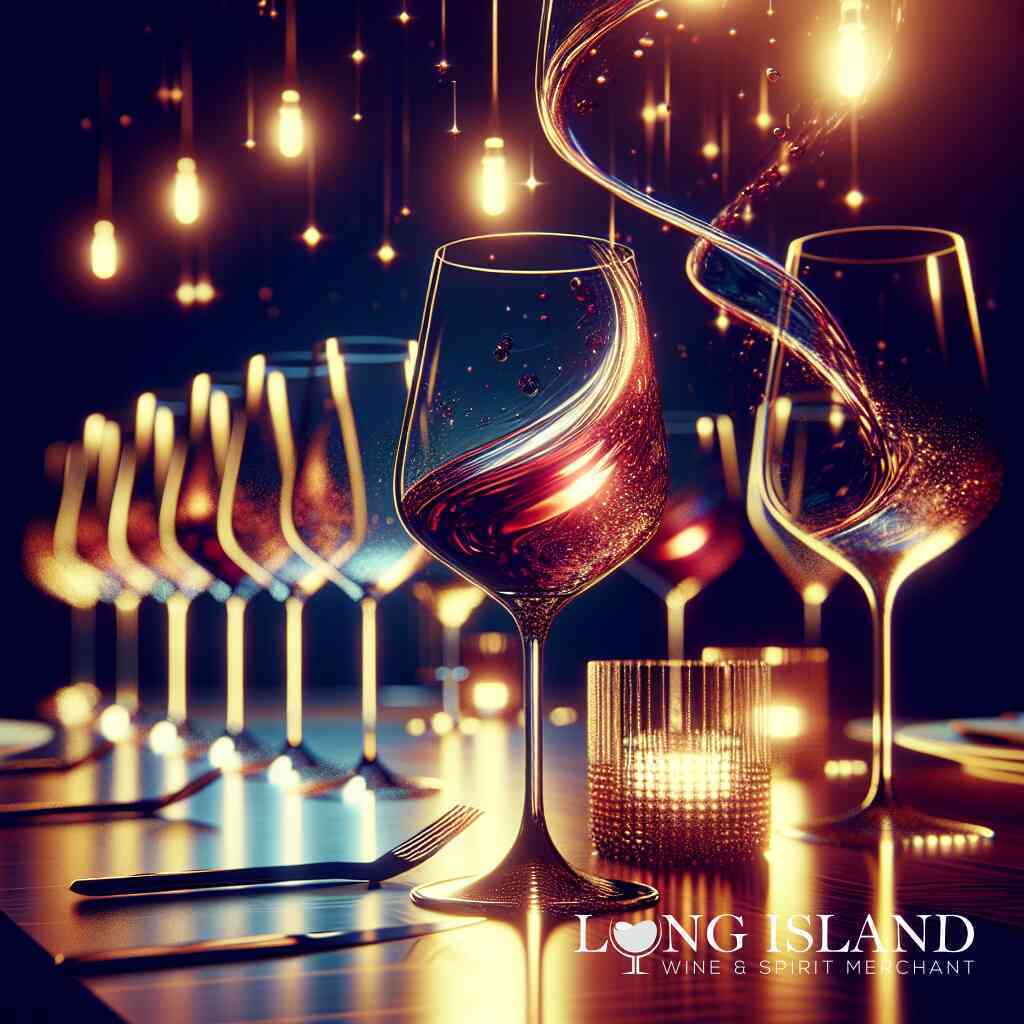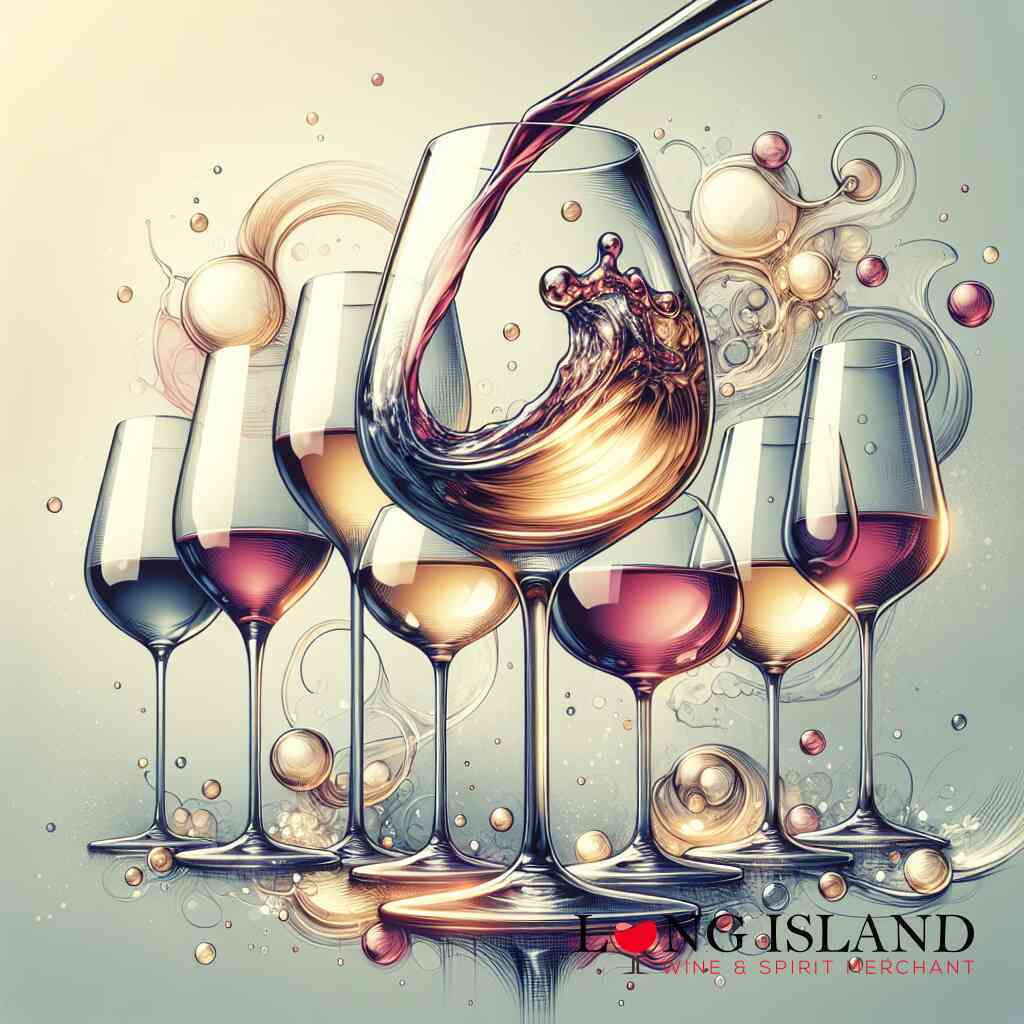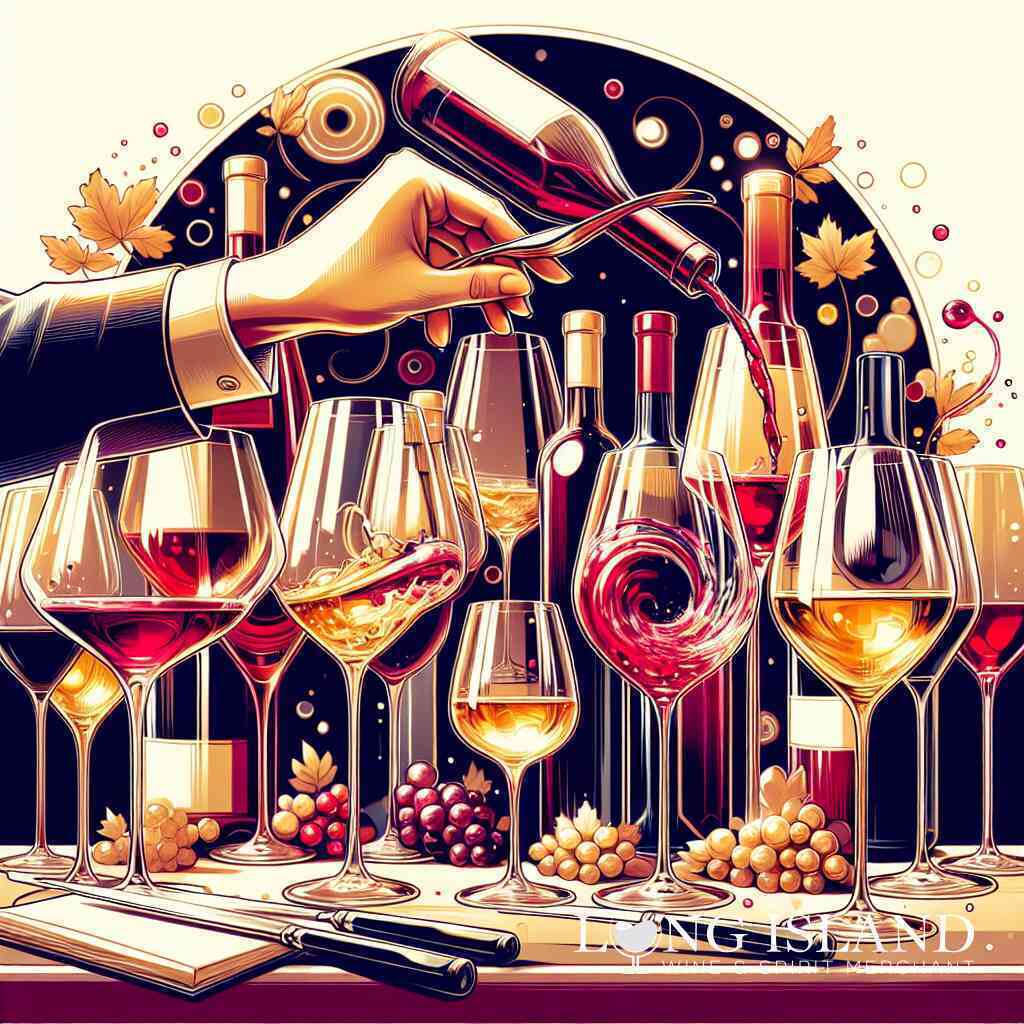
How to Hold a Wine Glass the Correct Way
May 23, 2024
Introduction to Wine Glass Etiquette
Understanding the Importance of Proper Wine Glass Handling
When delving into the world of wine, the way one holds a wine glass may seem like a negligible detail. However, it is a fundamental aspect of wine enjoyment and appreciation. Proper wine glass handling not only enhances the wine’s presentation but also improves the overall drinking experience. Handling a wine glass correctly ensures that fingerprints don’t cloud its clarity and that the temperature of the wine remains optimal. Every wine enthusiast, from beginners to connoisseurs, should recognize the importance of this etiquette to fully appreciate their favorite Long Island wine.
The Impact on Wine Aroma and Flavor Enhancement
The design of a wine glass is meticulously crafted to amplify the unique aroma and flavor profile of different wine varietals. For example, the wider bowl of a red wine glass allows the wine to come into contact with more air, enhancing its aromatics and flavor development. Enhancing wine aroma through glass shape is an intricate part of wine tasting that underscores the importance of using the right glass and holding it appropriately. By ensuring that the hand does not warm the bowl, the authentic characteristics of the wine are preserved, providing a more genuine and enjoyable tasting experience.
Setting the Stage for Sophisticated Wine Enjoyment
Engaging in proper wine glass etiquette sets the stage for a sophisticated and memorable wine experience. Whether attending an exclusive wine-tasting event or enjoying a quiet evening at home, the way one interacts with their wine glass can significantly influence the ambiance and perception of the wine. It demonstrates a level of respect and understanding for the wine’s journey from vineyard to glass. As we explore Long Island’s wine offerings, adopting these practices allows for a deeper appreciation of the region’s exquisite wine selection, elevating every sipping moment into a connoisseur-level experience.
The Anatomy of a Wine Glass
Understanding the anatomy of a wine glass is crucial for anyone looking to enhance their wine-drinking experience. Each component of a wine glass- be it red, white, or rosé-is designed with specific intentions, from the shape of the bowl to the length of the stem, all tailored to accentuate the wine’s aroma, flavor, and overall tasting experience.
Distinguishing Between Red, White, and Rose Wine Glasses
The design of wine glasses varies significantly across different types of wine, each crafted to bring out the unique characteristics of red, white, or rosé wines. Red wine glasses typically have a larger bowl, allowing the wine to breathe and develop its aromas fully. In contrast, white wine glasses often feature a more slender bowl, aiming to concentrate the more delicate aromas. Rosé wine glasses straddle the middle ground, with designs varying from wide to narrow bowls, rendering them versatile for showcasing rosé wines’ nuanced flavors. Understanding these differences is not just about aesthetics, it’s about respecting and enhancing the wine’s profile, ensuring that each sip is as the winemaker intended.
For those eager to dive deeper into the world of wine, exploring Long Island wine with the appropriate glassware can be a revelation, unlocking flavors, and aromas that standard glasses might not reveal.
Components of a Wine Glass: Bowl, Stem, and Base
A wine glass is more than just a vessel for serving your favorite Long Island wine, each part of the glass serves a purpose. The bowl holds the wine and is the main determinant of how wine aromatics are concentrated and presented to the drinker. The stem, often overlooked, is integral for temperature control, allowing the wine to be held without warming it with your hands. Finally, the base provides stability and ensures that the glass can stand upright, preventing spills. Understanding these components can significantly affect how one appreciates wine, emphasizing the role of glassware in the wine-tasting experience.
How Glass Shape Affects Wine Aromatics and Temperature
The shape of a wine glass influences the wine’s exposure to air and its temperature, which in turn affects the wine’s flavor and aroma. A wider bowl increases the surface area of the wine, enabling it to interact more with the air, thus enhancing the aroma and softening the flavors of robust red wines. In contrast, a tighter bowl keeps the wine cooler and concentrates the bouquet, which is ideal for white and rosé wines, allowing their crispness and aromatic subtlety to shine through.
Learning about wine temperature control by holding the stem is another aspect of glassware that enhances the wine’s enjoyment, maintaining the ideal serving temperature from the first pour to the last sip.
Adopting these practices not only enhances the wine’s sensory properties but also elevates the entire wine-drinking experience, making every glass of wine, whether it be a bold red, a crisp white, or a refreshing rosé, a more enjoyable and memorable moment.
Mastering the Correct Grip: Holding the Stem
Why Holding the Stem is Crucial for Temperature Control
When savoring a fine wine, every detail especially temperature, can significantly alter the wine’s flavor profile and aroma. The stem of a wine glass isn’t just a stylistic feature, it plays a crucial role in temperature control. By holding the glass by the stem, your hand does not warm the wine, preserving its intended taste and aroma. This practice is particularly important for enjoying the delicate flavors of wines from Long Island, where the climate contributes to unique wine characteristics that can be easily impacted by temperature changes. Furthermore, understanding the significance of this grip reinforces the comprehensive wine-tasting etiquette vital for every wine enthusiast’s knowledge.
Techniques for a Balanced and Gentle Wine Glass Grip
Achieving a proper wine glass grip is both an art and a skill, essential for enhancing the wine-drinking experience. A balanced grip entails lightly pinching the stem between your thumb and first two fingers, allowing the glass to rest on the base of your other fingers for added stability. This technique ensures minimal contact with the glass, thus preventing any unnecessary warming of the wine. For those exploring the exquisite selections at Long Island Wine & Spirit Merchant, practicing such techniques can markedly improve the enjoyment of their wine selection. Adjusting your grip based on the size and shape of the glass can also help maintain balance, ensuring each sip is as perfect as the last.
Common Mistakes in Wine Glass Handling to Avoid
While mastering the art of holding a wine glass, it’s equally important to recognize common handling errors. One of the most frequent missteps is gripping the bowl of the glass, which can cloud its clarity with fingerprints and alter the wine’s temperature, thus diminishing its flavors and aromas. Another mistake to avoid is holding the glass too tightly, which can lead to an uncomfortable experience and potentially even breakage. For those embarking on their wine journey in Long Island, it’s beneficial to heed these guidelines, ensuring each wine tasting is a reflection of proper etiquette and profound respect for the wine’s integrity. Training oneself to hold a wine glass correctly is a simple yet transformative step toward unlocking the full potential of Long Island’s renowned wines, elevating the overall tasting experience to new heights.

The Art of Swirling Wine
Unlocking the Aroma: The Science Behind Swirling
Swirling wine is not just an action to look sophisticated among fellow wine aficionados, it’s a technique steeped in enhancing the wine-tasting experience. The science behind swirling lies in its ability to aerate the wine, allowing oxygen to mix with the wine’s compounds, which helps to release the wine’s aromatics and flavors. This action elevates the volatile compounds present in wine, bringing the bouquet to the forefront. Long Island’s fine wines, known for their intricate aroma profiles, greatly benefit from this technique, making each sip more expressive and fragrant. Understanding the science behind swirling is crucial for any wine enthusiast looking to delve deeper into the nuances of Long Island wine-tasting etiquette.
Step-by-Step Guide to Swirling Wine Like a Pro
To master the art of swirling wine, one must practice patience and precision. Begin by placing your wine glass on a flat surface, this provides stability and prevents spills. Here’s a simple guide to perfect your swirling technique:
- Start by Gripping the Base: Use your fingertips to hold the base of the wine glass. This ensures that the temperature of the wine remains constant, and the grip is secure.
- Gentle Motion: Initiate a gentle circular motion with the glass. The aim is to coat the sides of the glass with wine, not to create a whirlpool.
- Gradually Increase the Speed: As you become more comfortable, slightly increase the speed to encourage more oxygen to mix with the wine.
- Observe the Legs: After swirling, observe the “legs” or “tears” that run down the sides of the glass. These offer clues about the wine’s body and alcohol content.
Remember, the purpose of swirling is to unlock the wine’s aroma, enhancing your overall tasting experience. For enthusiasts looking to refine their swirling technique, consider participating in a Swirling wine technique in the Long Island workshop.
Swirling Wine in Different Types of Glasses
The glassware chosen for wine significantly impacts the efficacy of swirling. Different shapes and sizes of glasses are designed to complement the characteristics of various wine types. For instance, a broad-bowled glass, ideal for robust red wines, allows for more aeration, which is beneficial for softening the tannins and enhancing the complexities of the wine. Conversely, a narrower glass, typically used for white wines, concentrates the aroma at the top of the glass, making the act of swirling more about intensifying the delicate scents rather than aeration.
Understanding the relationship between the wine glass design and the swirling technique is essential for any wine lover. Each swirl in the appropriate glassware can unlock different dimensions of aroma and flavor, making every Long Island wine tasting a unique exploration. Whether you are savoring a bold Red wine, a crisp White wine, or a refreshing Rosé wine, the art of swirling enriches the experience, bringing the intricate nuances of Long Island’s fine wines to the forefront.
Pouring and Serving Wine: Best Practices
Optimal Wine Serving Temperatures and Quantities
When serving wine, achieving the ideal temperature is paramount for maximizing flavor and aroma. Different wines flourish at various temperatures: a crisp white should be cooler than a robust red, enhancing its refreshing qualities. For white and rosé wines, aim for a temperature range between 45°F to 55°F, reds, however, shine between 55°F to 65°F, allowing their complex flavors to fully emerge. Quantities also play a crucial role in the serving process roughly five ounces per glass to savor the wine’s bouquet and palate without the risk of overindulgence. This measure ensures guests can appreciate a range of wines if desired. Adhering to these fine wine-serving tips on Long Island enhances the experience, letting each varietal’s unique character captivate your senses.
The Proper Way to Pour: Minimizing Drips and Splashes
Mastering the art of pouring wine not only elevates the elegance of serving but also minimizes waste and ensures a pristine presentation. Begin by gently wiping the bottle’s neck after removing the cork to prevent any potential drips. When pouring, hold the wine glass by the stem at a slight tilt and aim to pour wine into the center to allow it to aerate appropriately. As you finish pouring, twist the bottle slightly to prevent any drips. This technique ensures a smooth pour every time, reducing the risk of splashing or staining tablecloths. Perfecting this subtle skill underscores the sophistication and attention to detail vital for hosting memorable wine-tasting events or dinners.
Choosing the Right Glass for Each Type of Wine
The selection of the appropriate glassware is not merely a matter of aesthetics, it’s a testament to understanding and appreciating each wine’s profile. Red wines, with their complex bouquets and fuller bodies, are best served in glasses with a broad bowl, enhancing their aromatic diffusion and softening tannins. Whites, on the other hand, benefit from narrower glasses, which preserve their delicate fragrances and maintain a cooler temperature. Sparkling wines and champagnes excel in flutes, where their slender shape promotes effervescence and aroma concentration. Rosé wines, versatile in character, can be enjoyed in various glasses, though typically those with a slightly flared lip, encouraging the nuanced aromas to flourish. By choosing the right glass for each type of wine, hosts can elevate the tasting experience, allowing guests to perceive the full spectrum of flavors and aromas meticulously crafted by vintners.
Wine Glass Care and Maintenance
Cleaning Your Wine Glasses: Do’s and Don’ts
The way you clean your wine glasses can significantly impact their longevity and your wine-tasting experience. Proper cleaning removes residues and odors that could interfere with the delicate aromas of your Long Island wine. Do rinse your glasses with hot water immediately after use to prevent stains from setting. A gentle, non-abrasive detergent is ideal for washing, avoid those with strong fragrances that might cling to the glass. Don’t use the dishwasher for fine wine glasses, as the intense heat and rough handling can cause them to lose their luster or, worse, break. Instead, hand-wash them carefully and polish them with a lint-free cloth to avoid water spots and to ensure your wine glass shines. For those looking for specialized wine glass care products, Wine glass care and maintenance services from Long Island Wine & Spirit Merchant offer solutions that keep your glasses in pristine condition.
Storage Solutions to Preserve Wine Glass Integrity
Storing your wine glasses correctly is just as crucial as cleaning them properly. Incorrect storage can lead to scratches, chips, or breaks, reducing the aesthetic appeal and potentially affecting the wine’s taste. The best storage solution is to have a dedicated space where each glass can be placed upright, avoiding pressure on the delicate rim. Stemware racks or hanging systems not only save space but also keep your glasses free from dust and ready for your next Long Island wine tasting. If cabinet space is limited, consider using a stemware storage box with compartments that provide cushioning to prevent jostling and damage. Remember, a well-preserved wine glass can immensely enhance your enjoyment of fine wine and good spirits from Long Island.
When to Replace Your Wine Glasses
No matter how well you maintain your wine glasses, there comes a time when replacement becomes necessary. Scratches, cloudiness, or a dulled surface can detract from the wine-tasting experience by obscuring the wine’s true color and aroma. Additionally, any chips, especially on the rim or base, could pose a safety hazard. When you notice these signs of wear, it’s time to consider new glassware. Upgrading your wine glasses can be an opportunity to refine your collection, selecting shapes and styles that better suit your evolving wine preferences. Long Island Wine & Spirit Merchant offers an extensive selection of wine glasses tailored to enhance your appreciation of their fine wine and good spirits. Whether you’re exploring rosé wines, indulging in sweet red wine, or savoring a dry white wine, having the right glass in hand elevates the experience, making every sip a celebration of the rich wine culture Long Island has to offer.

Elevating Your Wine-Tasting Experience on Long Island
Incorporating Proper Wine Glass Etiquette into Wine Tasting Events
Planning and hosting a wine-tasting event on Long Island requires attention to the finer details that elevate the experience from ordinary to extraordinary. Incorporating proper wine glass etiquette is one such detail that enhances the sophistication and enjoyment of the event. When guests are informed or reminded of how to correctly hold a wine glass by the stem rather than the bowl-it not only optimizes their personal tasting experience by keeping the wine at its ideal temperature but also adds an element of elegance to the occasion. For those organizing Wine tasting event planning in Long Island, offering a brief tutorial at the start of the event can make a significant difference. It’s an educational touch that guests often appreciate, leading them to engage more thoughtfully with each wine selection presented.
Exploring Long Island Wine with the Right Glass in Hand
The journey through Long Island’s vineyards and wine selections becomes more immersive and educational when the right glass accompanies each wine. Understanding the significance of each glass’s shape and size in the wine it holds is key to unlocking the full spectrum of aromas and flavors. Whether sampling a delicate white, a complex red, or a refreshing rosé, using the appropriate glassware encourages a deeper appreciation and allows the wine’s characteristics to shine brightly. For enthusiasts and beginners alike, embarking on the ultimate guide to Long Island wine tours with this knowledge in hand transforms a simple tasting into a comprehensive sensory experience. Each glass of wine becomes a lesson in the art of winemaking and tasting, reflecting the richness of Long Island’s wine culture.
Enhancing Your Wine Knowledge and Enjoyment Through Wine and Spirits Education
The journey into wine appreciation is infinitely enriched by education, not just about the wines themselves but also about the nuances of wine and spirits. Engaging in formal or informal educational experiences can deepen one’s understanding and enjoyment of wine. This could involve participating in wine-tasting events that focus on teaching participants about Long Island wine and spirits, attending seminars, or even enrolling in courses designed to expand wine knowledge. As one becomes more familiar with the various aspects of wine differences between varietals, the significance of terroir, and the intricacies of wine-making techniques’ ability to enjoy and share wine multiplies. Establishments like Long Island Wine & Spirit Merchant offer ample education opportunities, from casual tastings to more structured learning sessions. Through education, wine lovers can transform their interest into a lifelong passion, continually discovering new wines, techniques, and traditions to explore.
These approaches to elevating one’s wine-tasting experience on Long Island exemplify how, with the right preparation and knowledge, anyone can enhance their appreciation for wine. By incorporating proper glass etiquette into events, selecting the appropriate glassware for each wine, and pursuing further wine and spirits education, enthusiasts can enjoy a fuller, more sophisticated wine experience.
Conclusion: Raising the Bar in Wine Enjoyment
Recap: The Significance of Wine Glass Etiquette
The art of holding a wine glass the correct way is more than a mere display of sophistication, it’s a fundamental aspect of wine enjoyment that enhances every aspect of the wine-drinking experience. Proper wine glass handling, from gripping the stem to the artful swirl, plays a pivotal role in the appreciation of wine’s aroma, flavor, and presentation. It prevents the warmth of the hand from altering the wine’s temperature, thus maintaining its intended character. Throughout this guide, we have explored the nuances of wine glass etiquette, from the anatomy of a wine glass to the meticulous care it requires. Each element underscores the deep respect for wine culture and the dedication to preserving the integrity of each sip, reflecting the rich tradition of Long Island’s winemaking heritage.
Future Trends in Wine Enjoyment and Glassware
As we look to the future, the evolution of wine enjoyment and glassware continues to be shaped by both innovation and tradition. A growing emphasis on sustainability may see an increase in eco-friendly materials and designs in wine glass production. The pursuit of a more intimate understanding of wine’s complexities might lead to the development of even more specialized glassware, designed to enhance the unique characteristics of lesser-known varietals. Additionally, digital integration into the wine-tasting experience, such as augmented reality labels or apps that recommend the perfect glass and serving temperature, could become more prevalent. These advancements promise to enrich the wine-tasting experience, making it more accessible, educational, and engaging for enthusiasts of all levels.
Invitation to Explore Fine Wine and Good Spirits with Long Island Wine & Spirit Merchant
As we embrace these future trends, the invitation to explore fine wine and good spirits remains warmly extended by Long Island Wine & Spirit Merchant. Situated in the heart of Commack, New York, on Long Island, our premier liquor store is a treasure trove of exquisite wine selections from sweet reds to crisp whites, and a remarkable array of spirits. Whether you’re a seasoned connoisseur or a curious newcomer, we offer everything you need to elevate your wine enjoyment – from personalized recommendations based on our wine taste quiz to exclusive wine-tasting events planned for 2024.
At Long Island Wine & Spirit Merchant, we believe that the journey of wine appreciation is ongoing, filled with discoveries and delights at every turn. We invite you to visit us, either in person at our shopping center location or online, to explore our carefully curated selection. Let us guide you through the world of wine and spirits, where each bottle tells a story of tradition, craftsmanship, and the simple joy of sharing good wine with friends and family. Together, let’s raise the bar in wine enjoyment, one glass at a time.
Frequently Asked Questions
Question: What is the proper way to hold a wine glass to best appreciate Long Island wine aromatics and flavors?
Answer: The proper way to hold a wine glass, especially when savoring Long Island wine, is by gripping the stem with your thumb, index, and middle finger. This technique is crucial for temperature control, ensuring the warmth of your hand doesn’t affect the wine’s optimal serving temperature. Holding the stem also maintains the wine glass’s clarity, avoiding fingerprints on the bowl that can obscure the wine’s color and texture. At Long Island Wine & Spirit Merchant, we emphasize wine glass etiquette as part of our comprehensive wine and spirits education, ensuring every sip of wine offers the full spectrum of its aroma and flavor profile.
Question: Can the shape of the wine glass enhance the wine-tasting experience, and how can I select the right glass for each type of Long Island wine?
Answer: Absolutely, the shape of the wine glass can significantly influence the wine-tasting experience by affecting the wine’s aroma and palate. Each type of wine glass, whether it’s a red wine glass with a larger bowl or a slender white wine glass, is designed to accentuate the unique characteristics of different wine varietals. For instance, red wine glasses allow for better aeration, enhancing the complex aromas, while white wine glasses maintain a cooler temperature for crispness. At Long Island Wine & Spirit Merchant, we offer an exquisite selection of fine wine and glassware designed to elevate your Long Island wine enjoyment. Our knowledgeable staff can assist you in selecting the right glass for your wine preference, enhancing your wine presentation and tasting experience.
Question: In the blog post “How to Hold a Wine Glass the Correct Way,” why is swirling wine considered an important technique for wine tasting?
Answer: Swirling wine is detailed in the blog post as an essential aspect of wine tasting technique because it aerates the wine, allowing oxygen to mix with the wine’s compounds. This release of wine aromatics and flavors is especially pivotal for appreciating the complex profiles of Long Island wine. By enhancing the volatile compounds present in wine, swirling elevates the bouquet to the forefront, making each wine tasting a more fragrant and expressive experience. At Long Island Wine & Spirit Merchant, we encourage enthusiasts to explore our wine and spirits education programs that include mastering such techniques, ensuring a deeper appreciation of wine-tasting tips, including the art of swirling.
Question: How does wine temperature control contribute to overall wine enjoyment, and how can Long Island Wine & Spirit Merchant help maintain this?
Answer: Wine temperature control is critical because the temperature at which wine is served can remarkably alter its taste and aroma. For example, serving a white wine too warm may dull its flavors, while a red wine served too cold could mask its aromatic complexity. Holding the wine glass by the stem, as recommended for proper wine glass etiquette, helps maintain the wine’s optimal temperature by preventing hand warmth from affecting the wine. wine glass etiquette At Long Island Wine & Spirit Merchant, we not only offer an array of Long Island wines suitable for serving at varied temperatures but also provide expert guidance on wine serving tips and the best practices in fine wine handling. Our selection includes temperature-controlled wine cases and wine racks that help preserve your wine at home in its ideal serving condition.
Question: What additional wine-tasting tips can enhance my wine enjoyment at Long Island wine events?
Answer: Beyond mastering the correct way to hold a wine glass, other wine-tasting tips can profoundly enhance your experience at Long Island wine events. These include understanding the nuances of wine and spirits education, such as recognizing the impact of terroir on wine flavor, learning the subtleties of different wine varietals, and engaging in mindful sipping to truly appreciate the depth and breadth of flavors in each glass. At Long Island Wine & Spirit Merchant, we pride ourselves on offering not just an exceptional selection of fine wine and good spirits but also opportunities for meaningful wine education. Whether through formal wine-tasting events planning or casual, guided tastings in our store, we’re dedicated to enhancing your wine knowledge and enjoyment, enriching your exploration of Long Island wine.



